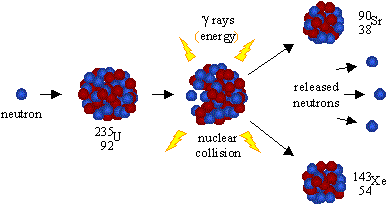

This inherent safety feature can be overwhelmed in extreme circumstances.Ĭontrol rods containing nuclides that very strongly absorb neutrons are used to adjust neutron flux. In case the reactor overheats and boils the water away, the chain reaction terminates, because water is needed to thermalize the neutrons. Control rods adjust neutron flux so that criticality is obtained, but not exceeded. A pressurized water reactor is cleverly designed to control the fission of large amounts of 235U, while using the heat produced in the fission reaction to create steam for generating electrical energy. Figure 4 shows a schematic of a reactor design, called the pressurized water reactor. Water is very effective, since neutrons collide with protons in water molecules and lose energy. As noted in Chapter 32.5 Fusion, energy is released if the products of a nuclear reaction have a greater binding energy per nucleon ( $latex \boldsymbol $, it is thus necessary to slow down (“thermalize”) the neutrons. (credit: Kalmthouts)įission is the opposite of fusion and releases energy only when heavy nuclei are split. The reactor is in the small domed building to the left of the towers. The cooling towers are the most prominent features but are not unique to nuclear power. About 16% of the world’s electrical power is generated by controlled nuclear fission in such plants.

The people living near this nuclear power plant have no measurable exposure to radiation that is traceable to the plant. China is building nuclear power plants at the rate of one start every month. France provides over 75% of its electricity with nuclear power, while the US has 104 operating reactors providing 20% of its electricity. By the end of 2009, there were 442 reactors operating in 30 countries, providing 15% of the world’s electricity. Whereas nuclear power was of little interest for decades following TMI and Chernobyl (and now Fukushima Daiichi), growing concerns over global warming has brought nuclear power back on the table as a viable energy alternative. Hundreds of nuclear fission power plants around the world attest to the fact that controlled fission is practical and, at least in the short term, economical, as seen in Figure 1. Spontaneous fission is a decay process in which an unstable nucleus spontaneously splits into smaller parts (lighter nuclei).

Controlled fission is a reality, whereas controlled fusion is a hope for the future. Fission into two fragments can either be induced by neutrons (induced fission) or occur spontaneously in the case of heavy isotopes (spontaneous fission). Nuclear fission is a reaction in which a nucleus is split (or fissured). Describe controlled and uncontrolled chain reactions.Discuss how fission fuel reacts and describe what it produces.


 0 kommentar(er)
0 kommentar(er)
